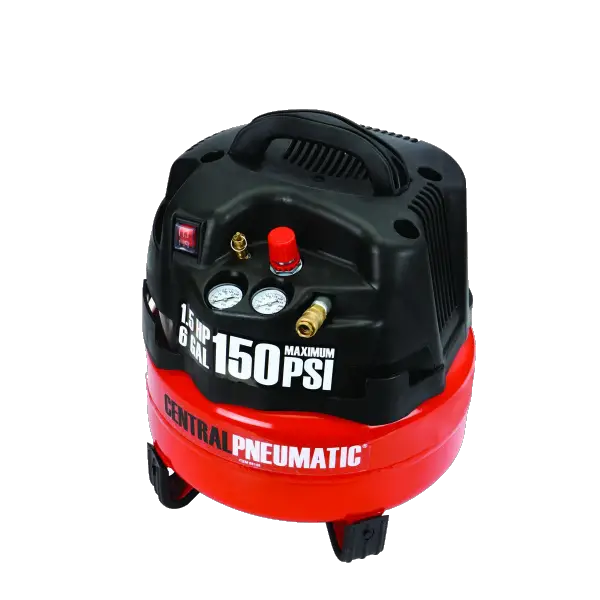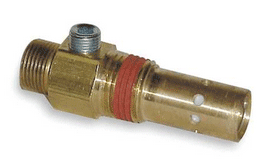Is your air compressor leaking air under the hood?
By that, we mean that you’ve got a smaller air compressor, the pump and motor are completely shrouded by a plastic cover, you cannot easily access under the hood, yet you can hear air leaking from out of there. Or, the compressor shuts down with a full tank, no air is used in an air tool, but after a while the tank pressure has dropped and continues to do so.
Trying to identify where compressor air is leaking under the hood can be a challenge.

First, let’s talk about the smaller air compressors. Typically, these have have a fractional HP motor (1 hp or less), have a single, very small cylinder, have a hole in the cylinder top plate to allow air to enter the cylinder compression chamber.
Is there a compressor bleeder hole?
Somewhere in the plumbing from pump cylinder to the tank fitting this type of air compressor typically has a small bleeder hole.
That bleeder hole is there to allow air to escape. Yes, all the while the compressor is pumping air is flowing into the tank, and also escaping from that bleeder hole. The hole is small enough so that most of the compressed air flows into the tank.
It’s when the compressor shuts down that the bleeder holes purpose becomes clear. It’s a no-moving-parts unloader port. Once the compressor stops, air should be trapped in the compressor tank by the tank check valve, and then, any air that’s trapped over the cylinder piston can then bleed out through this hole, removing piston load, and allowing a small air compressor motor to start more easily.
First, remove the compressor hood.
Sorry, but first you must try to figure out how the plastic cover is attached to the air compressor, and remove it.
Some of the compressor covers have easily visible screws or bolts, others have them buried deep within a plastic handle, or in some other obscure location. Some have metric bolts, others imperial measure. It can get complicated.
If you are having a problem getting the cover off a compressor, post a question below and be sure to add a photo. That may bring prompt help with that problem too.
Once the cover is removed run the compressor and after the tank is full the compressor will stop. Unplug the power cord as you do not want the compressor to start on its own when you are examining it.
Now you can hear the sound of air leaking if there is sufficient flow, and it is possible to feel around the cylinder and any holes you find in the plumbing, to determine if that is where the air is leaking from. Be careful, the pump and plumbing can be quite hot.
Where is the air streaming out of the leak actually coming from?
If the tank is full and the compressor is shut off, there is no more air being generated by the compressor pump. The bleed hole or valve would have drained all the air over the piston and in the line to the tank. Therefore, if air is leaking from somewhere, the only place the air can be coming from is from the compressor tank. There is no other source for air with the compressor off.
Therefore, if air is leaking from somewhere it is supposed to, like the unloader bleed hole for example, that air has to be coming from the tank.
It’s likely the compressor tank check valve.
If there is air leaking from anywhere on the upper compressor, the pump area, any of the plumbing, around the pressure regulator, the only place it can be coming from is the compressor tank, and the device that is supposed to keep the compressed air in the tank to be used when driving some sort of air tool, is the compressor tank check valve.

Inside the compressor tank fitting, where the air from the pump enters the tank, there is a check valve. It opens to allow air into the tank, and when air tries to flow back up out of the tank when the compressor shuts down, the flapper valve or ball check inside the tank check valve slams shut, and stops the air.
Or… the flapper or ball check is supposed to seal tight.
Over time the “seating” area of the flapper and ball check can build up debris from the air flowing into it. It doesn’t take much, and when that happens the flapper or ball cannot seal, and air flows back up out of the tank and out any opening to atmosphere.
Fix it!
First, with the compressor off, dump all of the air. You might want to cycle the pressure relief valve to dump the air as this ensures that, over time, crud hasn’t jammed it shut.
Remove the line to the tank fitting, remove the tank fitting, and rinse it in boiling water or solvent of some kind. Let dry, and reinstall.
Run the compressor to a full tank. If a leak persists after the compressor is shut down, dump the air again, remove the fitting and check valve, and using it as a guide, shop on line to find a replacement. There are lots, and there should not be any difficult finding another.
When the new check valve arrives, install it, test as noted above, and about 98% of the time this should have resolved the problem. If it doesn’t, oh my, post a comment here with the details of your compressor and where the air is leaking from.

